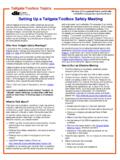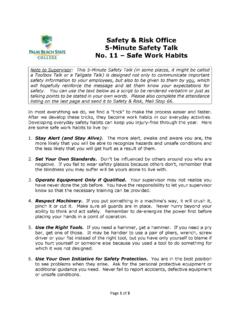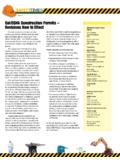Transcription of NYC Wastewater Resiliency Program
1 NYC Wastewater Resiliency Program2 Key safety Responsibilities Manage EHS in line with scope, schedule, and budget Provide competent and qualified EHS staff including management oversight Submit JHAs on a timely basis and address appropriate areas of work Conduct daily toolbox / tailgate meetings Ensure required and appropriate PPE is always worn on site Be alert to safety at all times3 AIR, NOISE, AND HAZARDOUS WASTE Update and enforce the Air Code to reduce local emissions, and regulate hazardous waste and noise pollutionAbout NYC DEPWATER SUPPLY Deliver one billion gallons of water to nine million New Yorkers every day and maintain 7,000 miles of water mains Protect our 2,000 square mile watershed, including 19 reservoirs and three controlled lakesWASTEWATER TREATMENT Treat billion gallons of Wastewater each day Operate and maintain 14 plants, 96 pumping stations, and 7,500 miles of sewers4 NYC DEP Bureau of Engineering Design & Construction (BEDC) develops, executes and transitions capital projects to: Bureau of Water Supply (BWS).
2 Conveys ~1 billion gallons of drinking water daily million acre watershed 19 reservoirs & 3 controlled lakes Bureau of Water & Sewer Operations (BWSO): Operation and Maintenance of the City s drinking water distribution and Wastewater collection systems Bureau of Wastewater Treatment (BWT) treats ~1,200 million gallons of Wastewater daily through: 14 Wastewater treatment plants 96 Pumping Stations 4 CSO storage facilities 5 BEDC Core ValuesBEDC s MissionTo run the safest most environmentally compliant capital construction Program in the United States. No accidents, no harm to people, and no harm to the Core ValuesSAFETYQUALITYSCHEDULE BUDGET CLIENT SERVICE6 DEP Environmental, Health and safety : Training EHS Orientation 10hr OSHA Construction Training EHS Standards Hazard-Specific Training Confined Space Entry LOTO Hazardous Materials Housekeeping Material Equipment Handling 7 NYC Wastewater Resiliency Program Harden DEP facilities against extreme weather events Construction Activity locations Wastewater Treatment Plants Pumping Stations Combined Sewer Outflow (CSO) Storage Facility Landfills Funding Sources New York State.
3 Environmental Facilities Corporation (EFC) Federal: FEMA8 Scope Item Example Elevate / Flood Proof Elevate small pumps Flood-proof sludge pumps by replacing with submersible Elevate control panels and instrumentationSubmersible pumpElevate PanelsElevate Panels9 Scope Item Example Seal Buildings / Pathways Add Sealants, Waterproof Doors/Hatches, Seal Penetrations and Reroute Vents Install Watertight Doors Install Watertight Windows Raise Vents and LouversFlood Prevention PanelFlood-Proof DoorFlood Barrier10 Scope Item Example Conduit Repair / ReplaceOverhead conduit runsAbove ground conduit11 Program Locations Overview12 Program StructureNYCDEPP rogram Management (AECOM)
4 Design Management (AECOM)TOC (D&B)TOC (Greeley and Hansen)TOC (Hazen & Sawyer)TOC (STV)Construction Management (AECOM)JOC 1 JOC 2 JOC 3 JOC (n)13 Construction ContractingJOC Contractfor Fixed Term or Maximum Dollar Value Bid Adjustment Factors Futurejob ordersUnit Price Book NYC Prices Designed around DEP type of workAssignments Fixed unit prices with Adjustment Factors applied Reconciliation on quantities and schedules Non-pre-priced items (as applicable)14 Anticipated Construction Contracts 22 Prime Contracts** 8 issued in Round 1 8 issued in Round 2 6 issued in Round 3 Contract Ranges 9 between $600K and $7M 13 between $15M and $30M M / WBE 30% goal**These contracts will be subject to the 2015 DEP Renovation & Rehabilitation PLA15 Project Labor Agreement Project Labor Agreement (PLA) An agreement by an owner (here, the City) with construction trades that all bidders must agree to as part of a responsive bid.
5 Subcontractors to be used by prime contractors on a City contract with a PLA must also agree to the terms of the PLA to be Labor Agreements and Prevailing Wage The PLA adjusts labor standards across PLA signatory trades including (but not limited to) holidays, overtime and shift pay Adjustments apply to all trades that signed the PLA which does not include Operating Engineers The PLA Does NOTchange the base hourly rate of pay and benefits17 Adjustments in the DEP Renovation PLA Eight (8) hours at Straight Time for day shift Eight (8) common holidays Four (4) days by ten (10) hour schedule available All overtime Monday to Saturday at rate Shift work at x base rate Saturday as weather make-up Day at Straight Time18 PLA: Key Concepts Bidders that assent to the PLA need not be signatory to any other union agreement(thus, open shop contractors that don t have union agreements are able to agree and bid) Key concept is that all of the provisions in the PLA apply to all contractors and all subcontractors on those City projects subject to a PLA19 PLAs.
6 Key Concepts Key concept is that under PLAs, contractors and subcontractors use union labor referred by the PLA signatory building trades (open shop and M/WBE contractors have bring-along provisions) All benefits for trade workers(including bring alongs ) will be paid to union benefit funds on a timely basis where workers are not union members, they are agency shop fee payers and will acquire union benefits without becoming union members per PLAs and DSBS Certified M/WBEs New York City (DSBS) certified M/WBE firms receive specific bring-along for contracts under $1M:oFor contracts at or below $500k 2nd, 4th, 6th, 8th workers per tradeoFor contracts between $500k and $999k 2nd, 5th, 8th workers per trade21 NYC PLAs and DSBS Certified M/WBEs Any person (including M/WBE bring alongs ) working in a trade capacity under a PLA, whether for the contractor or a subcontractor, that is not a member of the affiliated Building Trades Unions, must be registered with the appropriate PLA signatory union benefit fund [Article 11, Section 2]; and are subject to an agency shop fee [Article 4, Section 6].
7 DSBS Certified M/WBE firms that are or become union signatories (to a local that signed the PLA) get to bring all employees for the applicable trade subject to union standards of proficiency22 Tips For Contractors and SubcontractorsPrior to bidding: Carefully review the 2015 DEP Renovation PLA (including Schedule A CBAs relevant to the work you arebidding on)and the current Comptroller s Labor Law Schedule 220 Know the trade classifications and PLA labor standards that will be employed on the contract Take escalation into account when factoring labor wage costs into the bid pric












